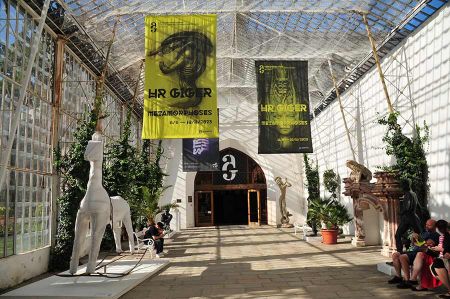Beginning 70s - Emerson, Lake and Palmer and HR Giger
- Written by Portal Editor
Time flies - it's sometimes frightening, because how strong the memory of 1969 is still present and with it our first ever concert with the progressive rock band "The Nice" with Keith Emerson on the keyboards and first synthesizers more than 50 years ago now - as if it were yesterday.
The following year, "The Nice" toured Europe and played at the Prague Beat Festival. Then “The Nice” celebrated at the three-day Pop & Blues Festival on the Easter weekend 28/29. March 1970 in Hamburg's Ernst-Merck-Halle their music once again in an emphatic night.
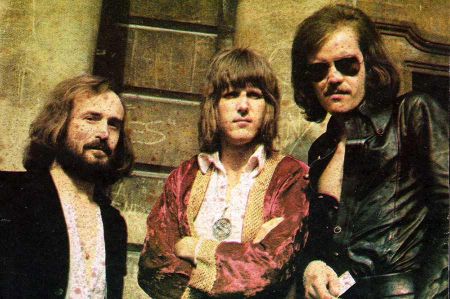 On March 30, 1970, the band gave their farewell concert in the Berlin Sportpalast.
On March 30, 1970, the band gave their farewell concert in the Berlin Sportpalast.
With the end of “The Nice” there was initially great disappointment, because who else would be able to interpret such various revisions of classical pieces, including those by Bach, Sibelius and Tchaikovsky, like Keith Emerson did with “The Nice”. Her best-known interpretations include works by Leonard Bernstein (America from West Side Story), Johann Sebastian Bach (Brandenburg Concertos) and Jean Sibelius (Intermezzo from the Karelia Suite).
But things turned out completely different - Emerson, Lake and Palmer
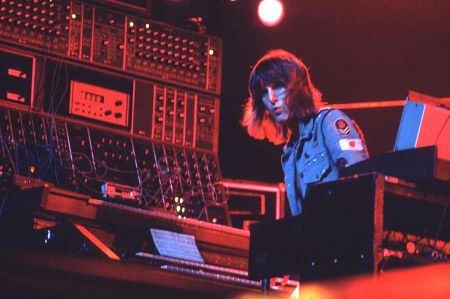 Shortly after "The Nice" ended in 1970, Keith Emerson and Greg Lake, bassist and singer of King Crimson, together with Carl Palmer, drummer of The Crazy World of Arthur Brown and Atomic Rooster, founded the band "Emerson, Lake and Palmer". Jimi Hendrix was originally planned to be a band member, so British press articles stated HELP as the expected band name - but this formation never came about, ultimately due to Hendrix's death in September 1970. The trio made their debut at the Isle of Wight Festival, and this appearance was followed by a supergroup career, from now on always abbreviated to ELP. The group's music is characterized by a keyboard-heavy mixture of different musical styles. In addition to jazz and blues influences, ELP became famous for the classical components in their music.
Shortly after "The Nice" ended in 1970, Keith Emerson and Greg Lake, bassist and singer of King Crimson, together with Carl Palmer, drummer of The Crazy World of Arthur Brown and Atomic Rooster, founded the band "Emerson, Lake and Palmer". Jimi Hendrix was originally planned to be a band member, so British press articles stated HELP as the expected band name - but this formation never came about, ultimately due to Hendrix's death in September 1970. The trio made their debut at the Isle of Wight Festival, and this appearance was followed by a supergroup career, from now on always abbreviated to ELP. The group's music is characterized by a keyboard-heavy mixture of different musical styles. In addition to jazz and blues influences, ELP became famous for the classical components in their music.
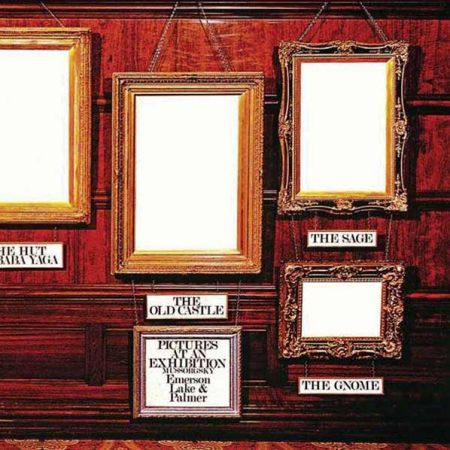 The live album “Pictures at an Exhibition” (1971) stands out from the extensive oeuvre, on which the band reinterpreted the images from an exhibition by the Russian composer Mussorgsky. In addition to original compositions such as the “Tarkus” suite, classical models by Bartók, Janáček, Bach, Ginastera, Copland, Gulda, Sullivan, Orff and Tchaikovsky were also adapted.
The live album “Pictures at an Exhibition” (1971) stands out from the extensive oeuvre, on which the band reinterpreted the images from an exhibition by the Russian composer Mussorgsky. In addition to original compositions such as the “Tarkus” suite, classical models by Bartók, Janáček, Bach, Ginastera, Copland, Gulda, Sullivan, Orff and Tchaikovsky were also adapted.
Singles such as “Lucky Man” (1970), “I Believe in Father Christmas” (1977) and “Fanfare for the Common Man” (1977) became global hits. With the albums Emerson, Lake & Palmer (1970), Tarkus (1971), Pictures at an Exhibition (1971), Trilogy (1972) and finally Brain Salad Surgery (1973), whose cover design by the Swiss artist HR Giger included the characteristic ELP Designed the logo that led the band from then on.
HR Giger designs the characteristic ELP logo
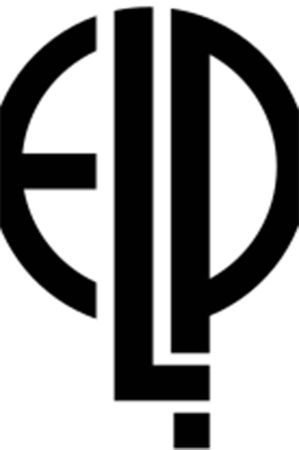 HR Giger was born in Chur as the son of the pharmacist Hans Richard Giger and his wife Melly Giger and was rather shy and reserved as a child. He was raised Catholic, which later influenced his art. After completing high school and training as an architectural draftsman, he studied interior architecture and industrial design at the School of Applied Arts in Zurich from 1962 onwards. During his training he created his first pen and ink drawings ("Atom Children"), after which he published his works in the underground newspapers "Hotcha!", "Clou", "Agitation" and "The Cthulhu News" by Robert A. Fischer. With his dark drawings, gloomy record covers and creations, he shaped the aesthetics of the death and black metal scene for decades. The record cover KooKoo for Debbie Harry and the cover Brain Salad Surgery for Emerson, Lake and Palmer are also considered milestones.
HR Giger was born in Chur as the son of the pharmacist Hans Richard Giger and his wife Melly Giger and was rather shy and reserved as a child. He was raised Catholic, which later influenced his art. After completing high school and training as an architectural draftsman, he studied interior architecture and industrial design at the School of Applied Arts in Zurich from 1962 onwards. During his training he created his first pen and ink drawings ("Atom Children"), after which he published his works in the underground newspapers "Hotcha!", "Clou", "Agitation" and "The Cthulhu News" by Robert A. Fischer. With his dark drawings, gloomy record covers and creations, he shaped the aesthetics of the death and black metal scene for decades. The record cover KooKoo for Debbie Harry and the cover Brain Salad Surgery for Emerson, Lake and Palmer are also considered milestones.
Brain Salad Surgery by ELP
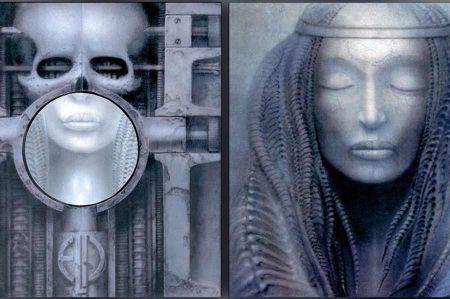 Brain Salad Surgery is ELP's fourth studio album and the first released on their own label Manticore. The title comes from the song Right Place, Wrong Time by Dr. John.
Brain Salad Surgery is ELP's fourth studio album and the first released on their own label Manticore. The title comes from the song Right Place, Wrong Time by Dr. John.
The best-known track on the album is Karn Evil 9: 1st Impression – Part 2 (“Welcome Back My Friends to the Show That Never Ends…”). Among other things, this first line of text in the piece has since been used to greet fans at concerts and became the title of the following live album. Due to its length and the fact that around 25 minutes fit on one LP side, the piece Karn Evil 9 was originally distributed over two LP sides on the record (1st Impression - Part 1 on the A side, the rest on the B -page) and referred to as two titles. However, on later CD releases these two parts were merged into one title. The lyrics were written by Greg Lake and his former King Crimson colleague Peter Sinfield.
The piece Toccata is an arrangement of the fourth movement of Ginastera's first piano concerto, with some synthesizer effects not coming from Keith Emerson, but from Carl Palmer, who used a new type of drum synthesizer here. The composer expressed his approval of Emerson's arrangement: “Keith Emerson has beautifully caught the mood of my piece.”
ELP album cover by HR Giger
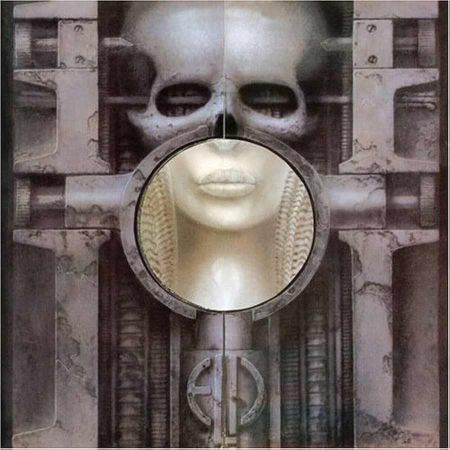 For the upcoming album, Peter Zumsteg, the record label's manager, introduced Emerson to artist HR Giger. In April 1973 the group played a two-day concert in Zurich as part of their European tour. After the concert, Emerson and Zumsteg visited the artist at his home. Coincidentally, under the influence of the music of Emerson, Lake & Palmer, Giger had just created a triptych entitled Work 216: Landscape XIX. When he revealed the triptych to his guests, Emerson immediately decided to use it for the album cover. Giger painted two new paintings, Work 217: ELP I and Work 218: ELP II, approximately the actual size of the vinyl record cover. The first image was chosen by the group as the cover image. It shows a human skull clamped in a machine in Giger's typical monochrome biomechanical style above the new ELP logo, also designed by Giger, which Emerson, Lake and Palmer has carried ever since.
For the upcoming album, Peter Zumsteg, the record label's manager, introduced Emerson to artist HR Giger. In April 1973 the group played a two-day concert in Zurich as part of their European tour. After the concert, Emerson and Zumsteg visited the artist at his home. Coincidentally, under the influence of the music of Emerson, Lake & Palmer, Giger had just created a triptych entitled Work 216: Landscape XIX. When he revealed the triptych to his guests, Emerson immediately decided to use it for the album cover. Giger painted two new paintings, Work 217: ELP I and Work 218: ELP II, approximately the actual size of the vinyl record cover. The first image was chosen by the group as the cover image. It shows a human skull clamped in a machine in Giger's typical monochrome biomechanical style above the new ELP logo, also designed by Giger, which Emerson, Lake and Palmer has carried ever since.
Fans of the band ELP and Giger's please pay attention:
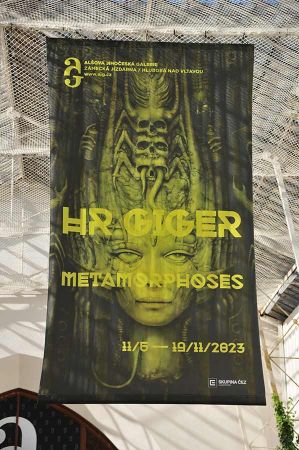 With the exhibition “Metamorphoses” the works of HR Giger can be seen for the last time and only until November 19th, 2023 in the South Bohemian Gallery Ales in the former neo-Gothic castle riding school in Hluboka nad Vltavou in the Czech Republic, which we would definitely like to recommend. Since the surroundings also contribute to a longer stay, a short vacation is ideal here, which we were just able to experience. And not just for lovers of classic rock history, as Giger was also very active in the film industry. As early as 1968 he was working exclusively as an artist and filmmaker. As a set and costume designer, his style influenced well-known films such as Alien (1979) and Species (1995). For his work on Alien, Giger won an Oscar for Best Visual Effects in 1980 and his style became known to a wider audience.
With the exhibition “Metamorphoses” the works of HR Giger can be seen for the last time and only until November 19th, 2023 in the South Bohemian Gallery Ales in the former neo-Gothic castle riding school in Hluboka nad Vltavou in the Czech Republic, which we would definitely like to recommend. Since the surroundings also contribute to a longer stay, a short vacation is ideal here, which we were just able to experience. And not just for lovers of classic rock history, as Giger was also very active in the film industry. As early as 1968 he was working exclusively as an artist and filmmaker. As a set and costume designer, his style influenced well-known films such as Alien (1979) and Species (1995). For his work on Alien, Giger won an Oscar for Best Visual Effects in 1980 and his style became known to a wider audience.
Aleš South Bohemian Gallery bis zum 19.11.2023 (Link zur Karte)
Hluboká nad Vltavou 144, 373 41 Hluboká nad Vltavou, Tschechien
Please read as well:
Review-Zurich: Interview and concert Loreena McKennitt
The Frankfurt Book Fair attracts - more attractive!
